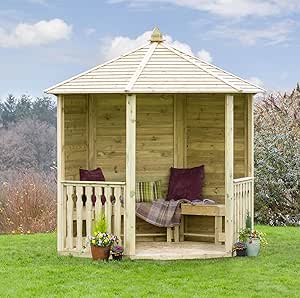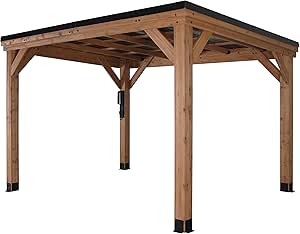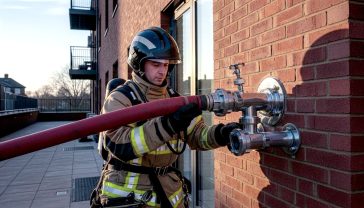Aluminium vs Metal vs Wooden Gazebos: The Ultimate UK Guide | Pros, Cons & Best Gazebo Buys
Aluminium, steel, or wood? This ultimate UK gazebo guide compares pros, cons, costs & styles. Discover which material is best for your garden & make the perfect choice!

This post may contain affiliate links. If you make a purchase through these links, we may earn a commission at no additional cost to you.
A gazebo can transform your garden, creating a sheltered haven for relaxation, dining, or entertaining. But with various materials on offer, choosing the right one – perhaps an aluminium gazebo, a robust metal gazebo (typically steel), or a classic wooden gazebo – can feel daunting. This comprehensive guide will walk you through the pros and cons of each, explore style options, maintenance needs, and costs, helping you find the perfect garden sanctuary for your UK home. We’ll look at everything from a small wooden gazebo to a large wooden gazebo, and a permanent metal frame gazebo to sleek aluminium designs.
Introduction: Choosing Your Perfect Garden Sanctuary
A gazebo is more than just a garden structure; it’s an extension of your living space, a focal point for outdoor enjoyment, and a promise of countless pleasant hours spent outdoors, shielded from the sun’s glare or a light British drizzle. The material you choose for your garden gazebo dramatically impacts its appearance, durability, maintenance requirements, and overall cost.
This article will delve into the three main contenders:
- Wooden gazebos, offering natural charm and versatility.
- Metal gazebos, primarily focusing on steel gazebos known for their strength.
- Aluminium gazebos, prized for their modern look and rust-proof qualities.
We’ll compare them head-to-head, so you can confidently decide which type of garden timber gazebo, sleek metal garden gazebo, or contemporary aluminium gazebo best suits your needs and complements your outdoor space.
Understanding Gazebo Materials: The Core Differences
Before we dive into the specifics, let’s clarify what we mean by each material type.
What is a Wooden Gazebo?
A wooden gazebo is crafted from timber, offering a traditional and organic aesthetic. Common types of wood for gazebo construction include softwoods like pine (often pressure-treated for longevity) and hardwoods such as oak or cedar. These structures can range from rustic to highly sophisticated designs.
- Technical Detail: Pressure treatment involves forcing chemical preservatives deep into the wood’s cellular structure. This process significantly enhances the wood’s resistance to rot, fungal decay, and insect attacks. “Tanalised” wood is a common term in the UK, referring to wood treated with Tanalith E, a specific type of preservative.
What is a Metal Gazebo? (Focus on Steel)
When people refer to a “metal gazebo,” they often mean one constructed from steel. Steel offers excellent strength and can support larger, more elaborate designs. To combat rust, particularly in the UK’s damp climate, steel frame gazebos are typically treated with processes like galvanisation or powder coating.
- Technical Detail: Galvanisation is a process where steel is coated with a layer of zinc. Zinc corrodes much more slowly than steel and sacrificially protects the steel underneath. Powder coating involves applying a dry powder electrostatically, which is then cured under heat to form a hard, durable finish.
What is an Aluminium Gazebo?
An aluminium gazebo is made from aluminium, a lightweight yet strong metal renowned for its natural resistance to rust. This makes it an excellent low-maintenance option. Aluminium frames are also often powder-coated, which provides colour and an additional layer of protection. These gazebos typically sport a modern, sleek look.
Gazebos vs. Pergolas: A Quick Clarification
It’s common for “gazebo” and “pergola” to be used interchangeably, but they are distinct structures.
- A gazebo is typically a freestanding, octagonal, hexagonal, square, or rectangular structure with a solid roof and often partially open sides. It’s designed to offer shelter from sun and rain. You’ll find options like a wooden gazebo with roof or a metal gazebo with roof and sides.
- A pergola (like a pergola wooden or metal frame pergola) is usually a more open structure, often with posts supporting cross-beams and an open-lattice roof, though some modern pergolas feature louvred or retractable canopies. They are often used to support climbing plants or define a walkway or seating area. While some keywords mention “metal roof on pergola” or “wooden pergola with roof,” a true traditional pergola is more open.
This article focuses on gazebos due to their more substantial shelter capabilities.
Wooden Gazebos: Natural Charm and Timeless Appeal
Wooden gazebos (or timber gazebos) are a popular choice in UK gardens, prized for their natural beauty and ability to blend seamlessly with various landscaping styles. From a simple DIY wooden gazebo kit to elaborate custom-built structures, wood offers a warm and inviting atmosphere.
Pros of Wooden Gazebos
Cons of Wooden Gazebos
Popular Types of Wood for Gazebos
Pine (Pressure-Treated): The most common and budget-friendly option for a gazebo with wood frame. When properly pressure-treated, pine offers good durability. It’s lighter than hardwoods, making DIY assembly easier.Cedar: A premium softwood prized for its natural resistance to rot, insects, and moisture. Cedar has a beautiful aroma and ages gracefully, often turning a silvery-grey if left untreated. It’s more expensive than pine but requires less chemical treatment.Oak: A traditional hardwood known for its exceptional strength and longevity. Oak gazebos are premium structures, heavy, and often more costly. They exude a sense of permanence and quality.Other Timbers: Larch and Douglas Fir are other durable softwoods sometimes used, offering good alternatives to pine with varying characteristics and price points.
Wooden Gazebo Styles and Features
Wooden gazebos come in a vast array of styles:
Traditional Wooden Designs vs Modern Gazebo Designs
Traditional designs often feature intricate details, balustrades, and pitched roofs. You might see hexagonal wooden gazebo or round wood gazebo shapes.
Modern wooden gazebos might have cleaner lines, flat or gently sloped roofs, and perhaps incorporate metal accents. A flat roof wooden gazebo is an example.
Wood Gazebo Styles and Features
Roofing options for a gazebo roof wood structure can include timber shingles, felt tiles, cedar shakes, or even more substantial slate or clay tiles for very robust frames.
Wooden gazebo with sides can feature solid panels for privacy and wind protection, trelliswork for climbing plants, or decorative balustrades. A wooden gazebo with roof and sides offers maximum shelter.
A corner wooden gazebo can make excellent use of garden space.
For those with hot tubs, a wooden gazebo for hot tub (or hot tub gazebo wooden) is a popular choice, offering privacy and shelter. Cedar is often preferred here due to its moisture resistance. Consider adequate ventilation.
You can find wood gazebo for sale from many retailers, including specialists like Dunster House gazebo or Tuin gazebos, which offer a range of kits.
Metal Gazebos (Steel): Strength, Durability, and Modern Lines
Steel gazebos are the workhorses of the metal gazebo world, offering impressive strength and a more contemporary aesthetic compared to traditional wood. They are often chosen for their resilience and ability to support features like hardtop roofs.
Pros of Steel Gazebos
Cons of Steel Gazebos
Key Steel Treatments and Finishes
To ensure longevity for your metal gazebo, look for these treatments:
Powder Coating: This is an electrostatic process where a dry coloured powder is applied to the steel and then baked in an oven. This creates a thick, durable, and attractive finish that is more resistant to chipping, scratching, and fading than traditional paint.- Simplified Explanation: Think of it like a very tough, baked-on paint job that protects the steel and gives it colour.
Galvanisation: This involves coating the steel with a layer of zinc. The zinc acts as a barrier against moisture and air, and even if scratched, it corrodes preferentially, protecting the steel underneath (this is called cathodic protection).- Simplified Explanation: It’s like giving the steel a special zinc jacket that stops rust.
- It’s best to look for gazebos that are galvanised and then powder-coated for maximum protection.
Steel Gazebo Styles and Features
Metal gazebo with roof: Roofs are often made from polycarbonate panels (which can be clear, tinted, or opaque and offer UV protection), corrugated metal sheets (a gazebo with a metal roof or steel roof gazebo), or sometimes heavy-duty fabric canopies on lighter steel frames. A solid roof gazebo made of metal offers excellent weather protection.
Metal gazebo with sides: These can include fabric curtains for a softer look and adjustable privacy/shade, or sometimes metal or polycarbonate panels for a more enclosed feel. A metal gazebo with roof and sides offers a very sheltered space.
Permanent metal frame gazebo: Designed for long-term installation, these are robust structures.
Shapes can vary, including square, rectangular, and sometimes round metal gazebo or metal circular gazebo designs.
You might find them marketed as garden steel gazebo or metal gazebo for garden. Some retailers like metal gazebo The Range might stock various options.
Aluminium Gazebos: Lightweight, Modern, and Rust-Proof
Aluminium gazebos have surged in popularity, offering a fantastic combination of modern aesthetics, low maintenance, and excellent durability, especially in the face of rust.
Pros of Aluminium Gazebos
Cons of Aluminium Gazebos
Understanding Aluminium Grades and Finishes
Manufacturers typically use specific aluminium alloys designed for structural strength and outdoor durability. While you might not see the exact grade advertised, reputable brands use appropriate alloys.
Powder coating is almost universally applied to aluminium gazebos. This isn’t primarily for rust prevention (as aluminium doesn’t rust) but to provide a durable, coloured, and UV-resistant finish, enhancing its appearance and lifespan.
Aluminium Gazebo Styles and Features
Many modern aluminium gazebos feature innovative roof systems, such as louvred roofs. These have adjustable slats that can be opened to let in sunlight or closed to provide full shelter and rainwater drainage, often through integrated guttering within the posts.
Aluminium gazebo with sides are common, with options including retractable fabric screens, fixed glass panels, or adjustable louvred side panels, offering flexibility in terms of privacy and weather protection. An aluminium pergola with sides might offer similar side features.
Polycarbonate roofing panels are also very common, offering a hardtop shelter that lets light through.
Designs are typically sleek and contemporary, often in shades of grey, black, or white.
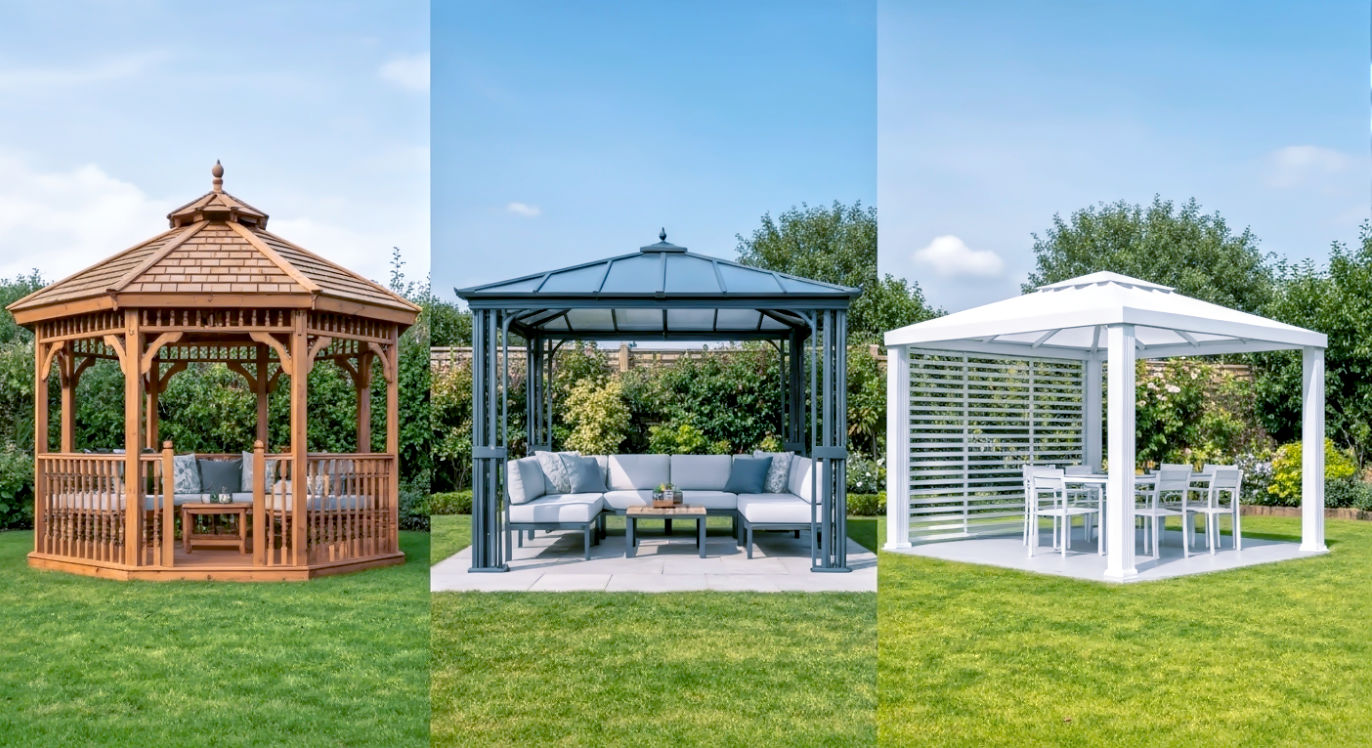
Direct Comparison: Wood vs Steel vs Aluminium
Let’s put these three materials side-by-side across key factors for a UK garden.
| Feature | Wooden Gazebo (Pine/Cedar/Oak) | Steel Gazebo (Galvanised/Powder-Coated) | Aluminium Gazebo (Powder-Coated) |
|---|---|---|---|
| Durability/Lifespan | Good to Very Long (with high maintenance for pine; cedar/oak more naturally durable) | Very Long (if coating maintained; rust is key risk) | Excellent (rust-proof; physical damage is main concern) |
| Maintenance | High (staining, sealing, pest checks, cleaning) | Moderate (check coating, touch up rust, cleaning) | Low (mainly cleaning) |
| Initial Cost | Low (Pine) to Very High (Oak/Cedar) | Moderate to High (quality dependent) | Moderate to Very High |
| Long-Term Cost | Can be higher due to maintenance supplies/labour | Moderate (potential rust repair if neglected) | Low |
| Aesthetic | Natural, traditional, rustic, versatile, can be painted/stained | Modern, industrial, strong, can be ornate | Sleek, contemporary, minimalist |
| Installation | DIY kits common (varies by size); can be heavy | Often requires professional help due to weight; solid base needed | Easier DIY for some due to lighter weight; must be anchored well |
| UK Weather Resistance | Good with treatment (wind, rain). Snow load depends on build. | Excellent for wind/snow (if robust). Coating vital for rain. | Excellent for rain (rust-proof). Good for wind if anchored. |
| Heat in Sun | Less conductive, can feel cooler | Can get very hot, frame and metal roof | Can get very hot, frame and metal roof |
| Environmental Impact | Good if FSC certified; treatments can be a concern. Renewable. | High energy to produce; recyclable. Durable. | High energy for virgin; highly recyclable with lower energy. |
Durability and Lifespan
- Wood: A well-maintained hardwood gazebo can last for decades, even generations. Pressure-treated pine, with diligent upkeep, can also offer 15-20+ years. Neglected wood will fail much sooner.
- Steel: High-quality, properly coated steel can last 20-30+ years. The key is preventing rust. Once rust takes hold on cheap steel, lifespan plummets.
- Aluminium: Because it doesn’t rust, an aluminium gazebo structure can last indefinitely. The powder coating may eventually fade or chalk after many years of UV exposure (15-20+ years for good coatings), but the underlying metal remains sound.
Maintenance Requirements
- Wood: Highest. Expect to inspect annually and re-treat every 2-5 years depending on the wood, treatment, and exposure.
- Steel: Moderate. Annual checks for coating breaches. Touch up any scratches immediately. Clean regularly.
- Aluminium: Lowest. Regular cleaning to remove dirt and garden debris is usually sufficient.
Cost Comparison (Initial and Long-Term)
- Initial: Generally, a basic pressure-treated pine wooden gazebo kit might be the cheapest. Good quality aluminium gazebos and robust, well-treated steel gazebos often sit in a mid-to-high price bracket. Premium hardwoods like oak will be at the top end. You can find cheap wooden gazebos for sale, but always check the timber quality and treatment.
- Long-Term: Wood incurs ongoing maintenance costs (stains, sealers, brushes, time). Steel might need rust treatment or repainting if the original coating fails. Aluminium has minimal long-term costs.
Aesthetic Appeal and Style Options
- Wood: Offers unmatched natural warmth and versatility. Can be painted any colour. Styles range from rustic log cabin gazebos to elegant Victorian designs.
- Steel: Can achieve fine details and curves for traditional looks, or bold, simple lines for industrial/modern styles. A black metal gazebo is a popular modern choice.
- Aluminium: Excels in contemporary, minimalist designs. Often features integrated features like louvred roofs.
Ease of Installation
- Aluminium: Often the easiest for DIY due to lighter components, though precision is needed.
- Wood: Kits are designed for DIY. Larger timber is heavy. Simpler designs are straightforward; complex ones need more skill.
- Steel: Due to weight, larger steel gazebos usually benefit from professional installation. Accurate assembly is crucial to maintain weather seals on hardtops.
Weather Resistance
- Wind: Heavy steel and well-anchored heavy timber/aluminium perform best. The overall design and quality of fixings are critical.
- Rain: All provide shelter with a proper roof. Wood requires sealing. Aluminium is impervious. Steel relies on its coating. Good drainage is key for all roof types.
- Snow Load: Robustly built steel and timber gazebos generally handle snow well. Check manufacturer specifications, as UK snow loads can vary. Aluminium designs also often have good snow ratings, especially those with polycarbonate or solid roofs.
Environmental Impact
- Wood: Best when FSC or PEFC certified, ensuring sustainable forestry. Treatments can have an environmental load. Carbon is sequestered in the wood.
- Steel: Production is energy-intensive. However, steel is highly durable and widely recycled.
- Aluminium: Virgin aluminium production is very energy-intensive. However, aluminium is infinitely recyclable with around 95% less energy. Look for recycled content if possible.
Key Considerations Before You Buy Your Gazebo
Choosing the right gazebo involves more than just picking a material. Consider these factors:
Purpose and Usage
How will you use your gazebo? For outdoor dining, as a quiet reading nook, a hot tub gazebo wooden enclosure, or for entertaining larger groups? This influences size and style. A wood barbecue gazebo or wooden bbq gazebo needs good ventilation and fire-safe placement.
Size and Space
Measure your garden carefully. Consider the gazebo’s footprint and the space needed around it for access and aesthetics. Common sizes include “3m x 3m gazebo” (or “3mx3m gazebo”) and “4m pergola” (translating to 4m gazebos). There are “small wooden gazebo” options for compact gardens and “large wooden gazebo” structures for grander spaces.
Location and Foundation
Choose a level spot. Will it be in full sun or partial shade? Is it exposed to strong winds? All gazebos require a stable foundation. This could be a concrete slab, paving stones, or a sturdy wooden deck. The heavier the gazebo (like large timber or steel), the more substantial the base needs to be.
Local Planning Permission and Building Regulations
In the UK, smaller garden structures like gazebos often fall under “permitted development rights” and don’t need planning permission. However, there are limits on size (especially footprint and height), proximity to boundaries, and usage. If your gazebo is very large, over a certain height (typically 2.5m if within 2m of a boundary), or in a conservation area/listed building curtilage, you must check with your local planning authority. Building Regulations might also apply for structural integrity or electrical installations.
Budget
Gazebo prices range from a few hundred pounds for basic models to many thousands for premium, large structures. Set a realistic budget that includes the gazebo itself, delivery, potential installation costs, and any necessary base preparation. Remember the “cheap wooden gazebos for sale” may have trade-offs in quality or longevity.
Roof Type and Material
The roof is critical. Options include:
- Fabric canopies: Common on budget-friendly or pop-up gazebos. Less durable, may need replacing.
- Polycarbonate: Lightweight, impact-resistant, lets light through (can be clear or tinted, UV-protected). Common on steel and aluminium gazebos.
- Metal sheeting: (Steel or aluminium) Very durable, offers full shade. Can be noisy in rain. A “gazebo roof metal” is a sturdy option.
- Timber (shingles, boards): Used on “wooden gazebo with roof”. Offers a natural look. Requires same maintenance as the frame. Options like a “gazebo roof wood” structure.
- Louvred roofs: Often aluminium, offer adjustable shade/shelter. A “solid roof gazebo” provides the best all-weather protection.
Sides and Enclosures
Do you want open sides, or some form of enclosure for privacy, wind protection, or insect screening?
Gazebo with sides wooden might use timber panels, trellis, or balustrades. Metal gazebo with sides often use fabric curtains/screens or polycarbonate/metal panels. An aluminium gazebo with sides might feature sleek screens or louvred panels. A wooden gazebo with roof and sides or a metal gazebo with roof and sides provides a more room-like feel. Even a black gazebo with sides can look very stylish.
Assembly: DIY vs Professional Installation
Consider your DIY skills, time, and the tools you have. Many gazebos come as kits (e.g., building a wooden gazebo).
- Aluminium: Often easiest due to lighter weight.
- Wood: DIY-friendly for many kits; larger structures may need help.
- Steel: Often benefits from professional assembly due to weight and need for precision. Factor in installation costs if you’re not doing it yourself.
Warranty and Supplier Reputation Look for a good warranty, especially against rust for steel gazebos, rot for treated wood, and significant defects for all types. Buy from reputable suppliers with good customer reviews. Companies like Dunster House pergola (and gazebos), Bulhawk (known for pop-ups but may offer more permanent), or specialist retailers offer varied ranges.
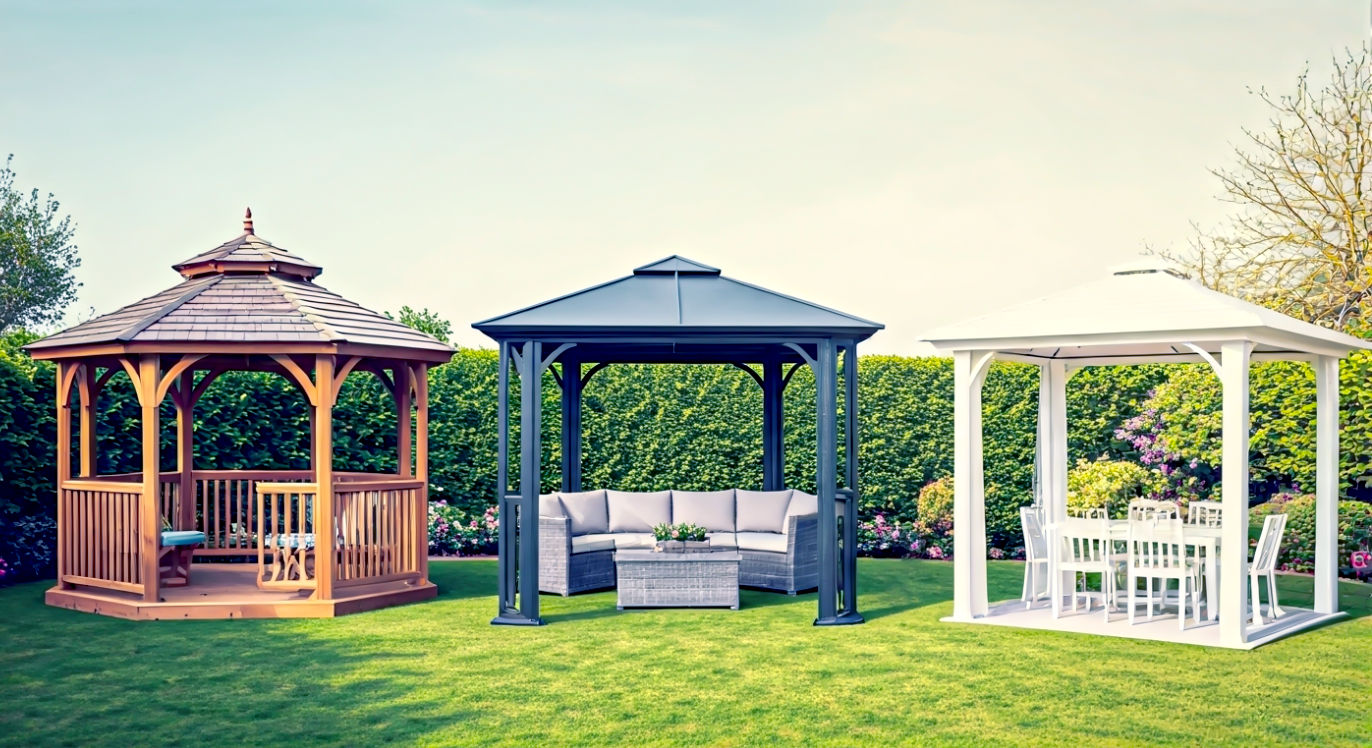
Best Buys: Making the Right Choice for Your Needs
“Best” is subjective and depends on your priorities. Here’s how to identify a good buy for each material:
Best Wooden Gazebo Buys: What to Look For
- Timber Quality: For budget options, ensure pine is properly pressure-treated (look for specifics on treatment level and expected lifespan). For a longer-lasting, more natural option, cedar is excellent. For ultimate strength, look at oak or other hardwoods, but expect a higher price.
- Timber Thickness: Chunky posts (e.g., 90mm+ or 4×4 inches+) and substantial roof beams indicate a sturdier structure.
- Treatment: Check the type and warranty of any protective treatments.
- Roofing: Ensure the supplied roofing material (e.g., felt shingles, timber boards) is good quality and suitable for UK weather.
- Fixings: Stainless steel or galvanised fixings are best to prevent rust stains on the wood.
- Examples:
- Good Value Family Choice: A pressure-treated pine wooden gazebo kit (e.g., 3m x 3m) with felt shingle roof.
- Natural & Low Maintenance: A Western Red Cedar gazebo, perhaps a hexagonal wooden gazebo design, for its beauty and rot resistance.
- Premium & Traditional: An oak-framed large wooden gazebo for a statement piece.
Best Metal (Steel) Gazebo Buys: What to Look For
- Protection: Crucially, ensure the steel is galvanised and then powder-coated. This dual protection is vital for UK longevity. Avoid “paint only” finishes on cheap steel.
- Frame Gauge: Thicker steel is generally better and more rigid.
- Roof Material: UV-resistant polycarbonate panels (at least 6mm thick) are common and good. A solid metal roof gazebo is also very durable.
- Warranty: Look for a specific warranty against rust perforation (e.g., 5-10 years).
- Fixings: Stainless steel bolts and screws are preferred.
- Examples:
- All-Weather Entertainer: A robust powder-coated and galvanised steel gazebo (e.g., 3m x 4m) with a hardtop polycarbonate roof and optional side curtains.
- Modern Statement: A steel frame gazebo with clean lines, perhaps in anthracite grey, featuring a solid metal or tinted polycarbonate roof.
Best Aluminium Gazebo Buys: What to Look For
- Aluminium Quality: Look for sturdy profiles; avoid very thin, flimsy-feeling frames.
- Powder Coating: A thick, even powder coating from a reputable brand will last longer.
- Innovative Features: Louvred roofs are a premium feature offering excellent versatility. Check the mechanism’s quality. Integrated guttering is a plus.
- Stability: Ensure it has robust anchoring plates and clear instructions for secure fixing. Wind rating, if provided, is a good indicator.
- Examples:
- Contemporary & Versatile: An aluminium gazebo with a manually or automatically operated louvred roof and optional side screens.
- Sleek & Low-Maintenance: A powder-coated aluminium frame with fixed polycarbonate roof panels for a bright, sheltered space.
Considerations for Specific Needs
Best Gazebo for Hot TubsVentilation is key to manage steam and humidity. Privacy is also important.- Wood: Cedar is excellent due to natural moisture resistance for a wooden gazebo for hot tub. Ensure good airflow.
- Aluminium: Rust-proof and can have louvred roofs/sides for controllable ventilation and privacy.
- Avoid basic steel unless exceptionally well-coated and ventilated, as prolonged high humidity can test its rust defences.
Best Gazebo for Windy AreasWeight and secure anchoring are paramount.- Steel: Heavy and stable if well-built and anchored.
- Heavy Timber (Oak/Dense Pine): Can be very wind-resistant.
- Aluminium: Must be very securely anchored. Look for designs with wind ratings. The frame’s structural integrity is also important.
Best Gazebo for Low Maintenance- Aluminium: Clear winner.
- Well-Coated Steel: Good, but requires vigilance for coating damage.
- Cedar Wood (if left to weather naturally): Lower maintenance than treated pine, but will change appearance.
Best Gazebo for DIY Enthusiasts- Wooden Kits: Widely available, with varying complexity. A diy wooden gazebo project can be very rewarding.
- Aluminium Kits: Generally easier to handle due to lighter parts, but often require more precise assembly.
Gazebo Maintenance Tips for Longevity
Whatever material you choose, some care will extend its life and keep it looking good.
Caring for Your Wooden Gazebo
- Regular Cleaning: At least annually, wash with mild detergent and water to remove dirt, algae, and bird droppings. A soft brush is best.
- Annual Inspection: Check for any signs of rot, insect activity, loose joints, or damaged wood. Pay attention to areas near the ground.
- Re-treat as Needed: Depending on the wood and previous treatment, re-apply a quality wood stain, sealant, or paint every 2-5 years, or as per the product manufacturer’s instructions. This is vital for a gazebo with wood elements.
- Trim Vegetation: Keep climbing plants and overhanging branches from constantly touching the wood, as this traps moisture.
Maintaining Your Metal (Steel) Gazebo
- Regular Cleaning: Wash with mild soap and water to remove grime. This also helps prevent corrosive substances (like bird droppings) from damaging the coating.
- Inspect Coating: Regularly check for chips, scratches, or bubbling in the powder coating or paint.
- Touch-Up Promptly: If you find any damage to the coating, clean the area, remove any loose rust (if it has started), and apply a suitable touch-up paint or rust inhibitor immediately to prevent rust from spreading on your steel metal gazebo.
- Check Fixings: Ensure bolts and screws are tight.
- Clear Drainage: If it has gutters or drainage channels (e.g., in a hardtop roof), ensure they are clear of leaves and debris.
Looking After Your Aluminium Gazebo
- Regular Cleaning: Usually, all that’s needed is a wash with mild soap and water and a rinse. Avoid abrasive cleaners.
- Check Fixings: Periodically check that all bolts and screws are secure.
- Lubricate Moving Parts: If you have a louvred roof or retractable screens, check manufacturer advice on lubricating any moving parts.
Conclusion: Your Ideal Gazebo Awaits
Choosing between an aluminium gazebo, a metal (steel) gazebo, or a wooden gazebo comes down to balancing your personal preferences for aesthetics, your budget, the amount of maintenance you’re prepared to undertake, and how you plan to use your outdoor space.
- Wood offers timeless natural beauty and customisation but demands the most upkeep.
- Steel provides exceptional strength and modern appeal but needs quality coating to fend off rust.
- Aluminium delivers a sleek, contemporary look with unbeatable rust resistance and low maintenance, often at a higher initial price.
By understanding the pros, cons, and key features of each material, as outlined in this guide, you’re now well-equipped to select a gazebo that will enhance your UK garden and provide years of enjoyment. Whether it’s a cosy small wooden gazebo for quiet afternoons, a grand large wooden gazebo for family gatherings, or a sophisticated aluminium gazebo with sides for chic entertaining, your perfect garden sanctuary is within reach.





